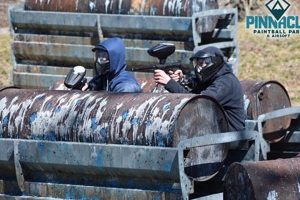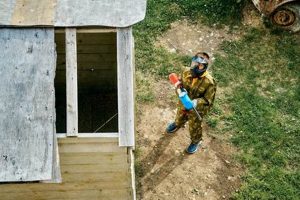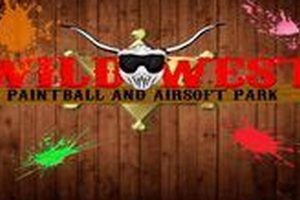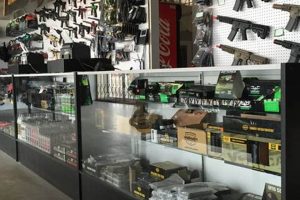Large-scale simulated combat activities involving projectile-based weaponry have gained considerable traction as recreational and team-building exercises. These activities utilize oversized markers or realistic replica firearms that discharge paint-filled capsules or plastic pellets, respectively, at participants.
The appeal of such engagements lies in their ability to foster strategic thinking, communication, and physical exertion within a controlled and regulated environment. Historically, these activities evolved from training exercises and have since become popular for corporate events, recreational outings, and competitive tournaments, offering participants an immersive and adrenaline-pumping experience.
The subsequent sections of this article will delve into the specifics of these activities, examining equipment variations, safety protocols, gameplay mechanics, and the distinct advantages offered by each type of simulation.
Strategic Recommendations for Oversized Projectile-Based Combat Simulations
The following guidelines are intended to enhance participant performance and safety within the context of large-scale simulated combat activities utilizing projectile weaponry.
Tip 1: Prioritize Protective Equipment. Mandatory eye protection and appropriate body coverings are crucial in mitigating potential injuries from projectile impacts. Ensure all equipment meets established safety standards and is correctly fitted.
Tip 2: Conduct Thorough Site Reconnaissance. Familiarize oneself with the designated playing area, identifying strategic vantage points, potential ambush locations, and optimal routes for movement. Pre-planning can significantly enhance tactical effectiveness.
Tip 3: Emphasize Clear Communication. Establish consistent communication protocols within the team. Utilizing concise terminology and pre-determined signals facilitates coordinated maneuvers and reduces the likelihood of misinterpretation during engagement.
Tip 4: Implement Tactical Maneuvering. Avoid static positioning. Employ flanking maneuvers, coordinated advances, and strategic retreats to maintain a dynamic and unpredictable presence on the field. Adapt tactics based on the evolving situation.
Tip 5: Conserve Ammunition Resources. Manage ammunition consumption effectively. Avoid unnecessary expenditure and prioritize accurate targeting. Efficient resource management ensures sustained engagement capability throughout the duration of the activity.
Tip 6: Maintain Situational Awareness. Continuously monitor the surrounding environment and track the movements of both allied and opposing forces. Proactive observation enables informed decision-making and facilitates rapid response to emerging threats.
Tip 7: Adhere to Established Rules of Engagement. Strict compliance with the governing regulations and ethical conduct are paramount. Unsportsmanlike behavior compromises the integrity of the activity and detracts from the overall experience.
Effective implementation of these strategies contributes to enhanced tactical proficiency, improved team cohesion, and a safer, more enjoyable experience. These considerations will be further expounded upon in the subsequent sections of this analysis.
1. Equipment specifications
The operational efficacy and safety of oversized projectile-based combat simulations are fundamentally linked to the specifications of the equipment utilized. The performance characteristics of the projectile markers or replica firearms, including velocity, accuracy, and effective range, directly influence tactical considerations and engagement distances. For example, a marker with a higher muzzle velocity may necessitate adjustments to engagement distances to mitigate potential injury, while a replica firearm with superior accuracy may allow for more precise targeting.
Protective gear specifications, such as impact resistance ratings for masks and body armor, are equally crucial. These ratings dictate the level of protection afforded to participants and must adhere to recognized safety standards to minimize the risk of injury. Furthermore, the design and ergonomics of the equipment impact maneuverability and overall user experience. Lighter, more ergonomic markers or replica firearms can reduce fatigue and improve responsiveness during prolonged engagements. The choice of propellant, whether compressed gas or spring-powered mechanisms, also affects marker performance and maintenance requirements, adding another layer of complexity to equipment selection.
In summary, a comprehensive understanding of equipment specifications is paramount for ensuring both safety and strategic effectiveness in simulated combat activities. Precise calibration of projectile velocity, rigorous safety standards for protective gear, and ergonomic design considerations directly influence the dynamics of engagement and the overall enjoyment of the activity. Neglecting these specifications can compromise participant safety and hinder the successful execution of tactical maneuvers.
2. Safety regulations
Adherence to comprehensive safety regulations is paramount in large-scale simulated combat activities involving projectile-based weaponry. These regulations serve to mitigate the inherent risks associated with the use of high-velocity projectiles and ensure participant well-being.
- Mandatory Protective Gear Compliance
Regulations necessitate the consistent and correct use of certified protective equipment, including full-face masks with appropriate impact resistance ratings and adequate body coverings. Non-compliance may result in immediate expulsion from the activity. This ensures all participants are shielded from potential injury during gameplay.
- Velocity Limits and Projectile Standards
Established velocity limits for projectiles, typically measured in feet per second (FPS), are enforced to prevent excessive force upon impact. Regulations also stipulate approved projectile types to ensure they meet safety standards for composition and biodegradability. Utilizing unauthorized projectiles or exceeding velocity limits constitutes a serious violation.
- Minimum Engagement Distances
Minimum engagement distances are implemented to reduce the risk of close-range injuries. These distances specify the closest proximity allowed between participants before firing a projectile. Failure to adhere to these distances may result in penalties or disqualification, depending on the severity and intent.
- Field Marshall Supervision and Rule Enforcement
Designated field marshals are responsible for monitoring gameplay, enforcing regulations, and resolving disputes. Their authority is absolute, and participants are obligated to comply with their directives. Marshals ensure fair play, safety compliance, and the overall integrity of the activity.
The strict enforcement of these safety regulations is integral to fostering a safe and enjoyable environment. Regular safety briefings, equipment inspections, and consistent rule enforcement contribute to minimizing the risk of injury and maintaining the responsible conduct expected within these activities.
3. Field dynamics
The physical environment, or field dynamics, significantly dictates the strategic approaches and tactical execution within large-scale projectile-based combat simulations. The layout of the playing area, including the presence of natural or artificial obstacles, elevation changes, and open spaces, creates a varied landscape that necessitates adaptable strategies. For instance, a field characterized by dense woodland necessitates close-quarters combat tactics and emphasizes concealment and flanking maneuvers. Conversely, an open field promotes long-range engagements and requires reliance on cover and suppressive fire. The strategic placement of bunkers or fortified positions also influences gameplay by creating focal points for offensive and defensive operations. Understanding these dynamic elements is paramount for effective team coordination and achieving objectives.
Consider, for example, an engagement scenario involving a capture-the-flag objective on a field divided into distinct sectors: a densely wooded area, a relatively open central zone, and a series of interconnected trenches. Effective teams adapt their strategies to suit each sector. The wooded area might be assigned to a specialized team focusing on stealth and infiltration, while the open zone requires a coordinated advance supported by suppressing fire. The trench system necessitates close-quarters combat skills and communication protocols for navigating confined spaces. Ignoring these field-specific nuances results in tactical disadvantages and increased vulnerability. The interplay between terrain, obstacle placement, and objective locations defines the operational environment and demands astute strategic planning.
In summary, field dynamics are a critical component of these simulated combat activities, influencing tactical decision-making and dictating the effectiveness of team strategies. The successful navigation and exploitation of the environment are crucial for achieving objectives and minimizing casualties. Effective teams conduct thorough reconnaissance, adapt their approaches to the specific challenges presented by the field layout, and prioritize situational awareness. A failure to recognize and adapt to field dynamics undermines tactical proficiency and increases the likelihood of mission failure.
4. Team strategies
Effective team strategies are paramount for success in large-scale simulated combat activities. The inherent complexities of these engagements necessitate coordinated planning, communication, and execution to overcome opposing forces and achieve objectives.
- Communication Protocols
Clear and concise communication forms the backbone of any successful team strategy. Standardized terminology, pre-determined signals, and dedicated communication channels are crucial for relaying information, coordinating movements, and adapting to evolving battlefield conditions. An example includes designated roles for relaying information about enemy locations. The lack of effective communication can lead to misinterpretations, delayed responses, and ultimately, mission failure.
- Role Specialization and Task Assignment
Effective teams leverage the diverse skill sets of their members through role specialization. Assigning specific tasks, such as reconnaissance, assault, or support, to individuals based on their strengths optimizes team performance. One team member might be more adept at long-range engagements. Efficient role specialization ensures that each aspect of the team’s strategy is executed by the most qualified personnel, maximizing overall effectiveness.
- Tactical Maneuvers and Formations
Pre-planned tactical maneuvers and formations are essential for coordinating team movements and maximizing offensive and defensive capabilities. Examples include flanking maneuvers to outflank enemy positions, suppressing fire to provide cover for advancing teammates, and defensive formations to protect critical objectives. The implementation of effective tactical maneuvers requires rigorous training and coordination to ensure seamless execution under pressure.
- Adaptability and Contingency Planning
Unforeseen circumstances and evolving battlefield conditions necessitate adaptability and contingency planning. Teams must be prepared to deviate from their initial strategy, improvise solutions, and respond effectively to unexpected challenges. This involves identifying potential risks, developing alternative plans, and empowering team members to make decisions autonomously within a clearly defined framework. Adaptability ensures resilience and increases the likelihood of success in dynamic and unpredictable environments.
These strategic elements are inextricably linked, forming a cohesive framework for maximizing team effectiveness in simulated combat activities. Success hinges on the ability to integrate these components seamlessly, fostering synergy and promoting a unified approach to achieving objectives. The application of sound strategic principles, coupled with diligent preparation and effective execution, is the hallmark of high-performing teams.
5. Objective completion
In large-scale simulated combat activities involving projectile weaponry, objective completion serves as the central determinant of success. These activities, whether categorized as oversized paintball or realistic airsoft engagements, are structured around pre-defined objectives that necessitate strategic planning, coordinated execution, and effective communication among participants. Objective completion, therefore, is not merely an ancillary aspect but the fundamental purpose for engagement, dictating the allocation of resources, the deployment of tactical maneuvers, and the overall assessment of performance. The objectives themselves may range from simple capture-the-flag scenarios to complex, multi-stage missions requiring the acquisition of designated targets, the elimination of opposing forces, or the securement of specified zones. Regardless of the specific objective, its successful completion is the metric against which team effectiveness is evaluated.
The causal relationship between strategic planning and objective completion is demonstrably significant. Teams that invest in comprehensive reconnaissance, develop adaptable contingency plans, and establish clear communication protocols are statistically more likely to achieve their objectives. Consider, for instance, a scenario requiring the capture of a fortified position. A team that conducts thorough reconnaissance to identify weaknesses in the defensive perimeter, allocates specialized roles to breach the fortifications, and establishes a clear chain of command for coordinating the assault has a demonstrably higher probability of success than a team that lacks such preparation. In practical terms, this translates to a higher win rate in competitive tournaments and a more satisfying and engaging experience for recreational participants. The significance of objective completion is further underscored by the competitive nature of these activities, where success translates to tangible rewards, recognition, and enhanced reputation. Furthermore, the achievement of objectives fosters a sense of accomplishment, promotes team cohesion, and reinforces the value of strategic thinking and coordinated action.
In conclusion, objective completion is the defining element of simulated combat activities. It serves as the focal point for strategic planning, tactical execution, and performance evaluation. While the inherent challenges of achieving these objectives contribute to the dynamic and engaging nature of these activities, the ability to overcome these challenges through effective teamwork, strategic thinking, and diligent preparation is the ultimate determinant of success. The understanding of this fundamental relationship is crucial for participants seeking to enhance their performance, improve their strategic acumen, and maximize their enjoyment of large-scale projectile-based combat simulations.
6. Scenario design
Scenario design is a critical determinant of the experience within large-scale projectile-based combat simulations. The framework established by the scenario dictates the parameters of engagement, influencing tactical considerations, resource allocation, and overall participant satisfaction. A well-constructed scenario provides a clear set of objectives, defined boundaries, and specific rules of engagement, fostering a sense of immersion and strategic challenge. Poorly designed scenarios, conversely, can lead to confusion, frustration, and a diminished sense of realism. For example, a scenario lacking clear objectives may result in aimless wandering and a lack of tactical focus, while poorly defined boundaries can create disputes and compromise the integrity of the activity. The causal relationship between scenario design and participant engagement is therefore demonstrably significant.
Practical examples illustrate the importance of scenario design. Consider a scenario simulating an urban warfare environment, characterized by multi-story buildings, narrow alleyways, and fortified positions. An effective design incorporates elements of reconnaissance, infiltration, and close-quarters combat, requiring teams to coordinate their movements, utilize specialized equipment, and adapt to the unpredictable nature of urban terrain. Conversely, a scenario set in the same environment but lacking these elements may devolve into a chaotic free-for-all, devoid of strategic depth or meaningful objectives. The design of a successful scenario also takes into account the number of participants, the size of the playing area, and the skill level of the players. A scenario designed for a small group may become overwhelming in a large-scale engagement, while a scenario that is too complex may frustrate novice participants. Careful consideration of these factors is essential for creating a balanced and engaging experience for all involved.
In conclusion, scenario design is an integral component of successful projectile-based combat simulations. It provides the framework for engagement, influences tactical considerations, and ultimately determines the level of participant satisfaction. While the complexities of scenario design present challenges, the benefits of a well-constructed scenario, including enhanced realism, increased strategic depth, and improved overall experience, are demonstrably significant. Recognizing the importance of scenario design is crucial for organizers and participants alike, as it directly impacts the quality and enjoyment of these simulated combat activities.
7. Ammunition types
Ammunition types are intrinsically linked to the dynamics of large-scale simulated combat. In paintball, the projectile is a spherical, gelatinous capsule containing a non-toxic, water-soluble dye. Its composition directly affects factors such as impact force, accuracy, and visibility upon target contact. Variations exist, including different fill colors for team identification and specialized formulations designed for improved all-weather performance or enhanced marking capabilities. Airsoft utilizes spherical plastic projectiles, commonly referred to as BBs, typically 6mm or 8mm in diameter. Their weight and material composition, which range from standard plastic to biodegradable alternatives and heavier variants for increased accuracy, influence range, trajectory, and impact. The choice of ammunition directly affects the play style and tactical considerations, influencing engagement distances, penetration capabilities, and the overall realism of the simulation.
The selection of appropriate ammunition necessitates adherence to safety regulations and field-specific rules. For example, many paintball facilities mandate the use of paintballs sourced from approved vendors to ensure consistency in quality and minimize the risk of marker damage. Airsoft fields often impose limits on BB weight to prevent excessive impact force and potential injury. The use of unauthorized or modified ammunition can result in penalties or expulsion from the activity. Furthermore, environmental considerations often dictate the adoption of biodegradable projectiles, minimizing the ecological impact of large-scale engagements. The practical application of ammunition knowledge extends to optimizing marker or replica firearm performance. Proper storage, maintenance, and selection of the correct ammunition type are essential for achieving consistent velocity, accuracy, and reliability. Experienced participants often experiment with different ammunition types to identify the optimal choice for their equipment and playing style.
In summary, ammunition types are a fundamental component of simulated combat activities, influencing safety, tactical considerations, and overall performance. The selection of appropriate ammunition necessitates adherence to regulations, consideration of environmental factors, and a thorough understanding of its impact on marker or replica firearm performance. While the diversity of ammunition types offers opportunities for customization and optimization, it also presents challenges related to safety compliance and performance consistency. A comprehensive understanding of ammunition characteristics is therefore essential for participants seeking to maximize their effectiveness and enjoyment of large-scale simulated combat.
Frequently Asked Questions
This section addresses common inquiries concerning large-scale simulated combat activities utilizing projectile-based weaponry, providing clarification on key aspects of participation and safety.
Question 1: What are the primary distinctions between giant paintball and airsoft activities?
The fundamental difference lies in the type of projectile employed. Giant paintball utilizes markers that discharge paint-filled gelatin capsules, while airsoft utilizes replica firearms that discharge spherical plastic projectiles. The impact characteristics and marking capabilities of these projectiles differ significantly, influencing tactical considerations and safety requirements.
Question 2: What are the mandatory safety requirements for participation?
Mandatory safety requirements invariably include the consistent use of certified protective eyewear, such as full-face masks with appropriate impact resistance ratings. Additional protective gear, including body coverings and gloves, is strongly recommended. Adherence to established velocity limits for projectiles and minimum engagement distances is also strictly enforced.
Question 3: What types of scenarios are commonly employed in these activities?
Common scenarios encompass capture-the-flag, team deathmatch, and objective-based missions involving the acquisition of designated targets or the securement of specific zones. Scenario complexity varies depending on the skill level of the participants and the size of the playing area.
Question 4: What level of physical fitness is required for participation?
While a high degree of athleticism is not mandatory, a reasonable level of physical fitness is beneficial. These activities often involve prolonged periods of running, crouching, and maneuvering, requiring a degree of stamina and agility. Pre-existing medical conditions should be disclosed to event organizers.
Question 5: Are there age restrictions for participation in these activities?
Age restrictions vary depending on the event organizer and local regulations. Generally, participants under the age of 18 may be required to obtain parental consent. Minimum age requirements are typically in place to ensure participant maturity and the ability to comprehend and adhere to safety regulations.
Question 6: What are the ethical considerations for participants?
Ethical considerations include adherence to the rules of engagement, respecting the boundaries of the playing area, and refraining from unsportsmanlike conduct. Honesty and integrity are paramount, particularly in scenarios where self-reporting of hits is required.
The information presented in this FAQ section serves as a general overview. Specific regulations and requirements may vary depending on the event organizer and the location of the activity.
The subsequent section will address advanced tactical considerations for participants seeking to enhance their performance.
Giant Paintball and Airsoft
This examination has detailed the complexities inherent in large-scale simulated combat activities. The analysis encompasses equipment specifications, stringent safety regulations, the dynamic influence of field layouts, coordinated team strategies, the criticality of objective completion, the impact of scenario design, and the strategic importance of ammunition types. Mastery of these elements is essential for effective participation.
The future of “giant paintball and airsoft” hinges on continued innovation in equipment technology, rigorous adherence to safety protocols, and the development of sophisticated scenarios that promote strategic thinking and teamwork. Further research into optimal training methodologies and the psychological benefits of these activities warrants consideration, ensuring their continued value as both recreational pursuits and team-building exercises.





![Top Picks: Best Paintball Mask for Airsoft Players [Guide] Ultimate Airsoft Guide for Beginners, Tactics & Gear Reviews Top Picks: Best Paintball Mask for Airsoft Players [Guide] | Ultimate Airsoft Guide for Beginners, Tactics & Gear Reviews](https://airsoftica.com/wp-content/uploads/2025/11/th-718-300x200.jpg)

